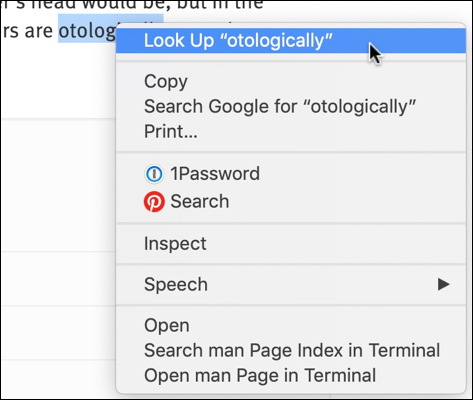

#SEARCH A PAGE FOR A WORD MAC MANUALS#
As such, it is especially useful in long documents, such as manuals and reports. Introduced in Office 2004, you can use the navigation pane to quickly move to any page or heading in the current document. To use "click and type" (discussed later in this chapter), you must switch to Page Layout, Online Layout, or Notebook Layout view.Although Page Layout view constantly displays useful layout information (such as margins, page breaks, and so on), writing in Word is usually fastest when done in Normal view.Master Document view is only accessible from the View menu.Click the Normal, Outline, Page Layout, or Notebook Layout icon in the bottom-left corner of the document window ( Figure 3.2).Used to quickly record notes and ideas (both in text and audio form).Įnables you to form a compound document composed of individual documents. Shows the document as it would appear in a Web browser. Shows the document as it will look when printed, including the page borders, margins, headers and footers, columns, and frames that contain images. Shows the document's structure and allows you to rearrange text by dragging headings. Shows text formatting in a simplified page layout that lends itself well to most standard writing tasks. You can select from Normal, Online Layout, Page Layout, Outline, Notebook Layout, and Master Document views. Changing viewsĬhanging the layout often requires that you view a document in different ways.

They'll be referred to throughout the chapters in Part II of this book.įigure 3.1 The Word window. If this is the first time you've used Word, you should start by familiarizing yourself with the Word window and its components ( Figure 3.1).
#SEARCH A PAGE FOR A WORD MAC HOW TO#
Other chapters in Part II explain document and text formatting, how to include images in your Word documents, designing tables, and employing more advanced features to create professional-looking documents for use in home, school, and business. While you can get along fine without mastering the material in this chapter, having a familiarity with it will make your Word experience more productive. However, because many of these features and techniques are common to all Office applications, they've already been discussed at length in Chapter 1.Įxpanding on the material in Chapter 1, this chapter covers additional elementary features that are specific to Word. Normally, the first chapter in a Part covers a program's basic features, such as how to create, open, and save documents, edit text, and the like. For more information on Microsoft Office, visit our Microsoft Office Newsletter.


 0 kommentar(er)
0 kommentar(er)
